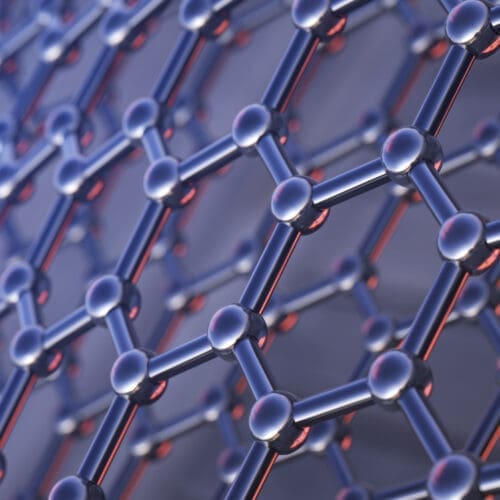Graphene – leading the ‘clean’ materials revolution?
May 2023The use of experimental materials in construction is becoming increasingly popular as developers, consultants and contractors look for new ways to increase sustainability and efficiency in the construction process.
Given the ever growing pressure for industry stakeholders to help the UK meet environmental targets and policies, as well as the significant inflation risks the market has faced in the past year, project owners and their supply chain are considering if these new materials will help them comply with green requirements whilst still turning a profit.
Graphene is one such material that has been discussed, and it is getting closer to being implemented on a commercial scale.
Graphene is a material made of a single layer of carbon atoms arranged in a hexagonal lattice. Its unique properties, such as high strength, conductivity, and transparency, have made it the subject of much research in recent years, including into its potential use within the construction market (as well as other markets). One particular focus has been on graphene-augmented products, such as structural steel and concrete.
Environmental Considerations
Concrete has been reported as one of the most destructive materials on Earth, yet after water, it is the most used substance in the world, with twice the usage of plastics, wood and aluminium and steel combined. There is a British materials company that has created a graphene-based additive for concrete that reportedly increases the strength of concrete by 30-50% above that of standard concrete. As a result, the business claims that the volume of cement required can be significantly reduced without impairing performance whilst also improving other characteristics, such as, leading to reductions in cracking.
These innovations are recognised across the Atlantic as well, with a Canadian company recently announcing their first graphene-enhanced product for the concrete market. Again, focussing on the sustainability benefits of the product, they claim to have the capacity to convert 100% organic materials into high-quality graphene via a patented cleantech process. In using this sustainable graphene, the Canadian business is able to produce a strength performance admixture for commercial concrete mix designs with the primary aim of the reduction in cement use.
This sounds promising, and if further testing replicates the initial test results on strength and durability and these products can be manufactured in an economical and green way, new experimental materials like graphene could have significant benefits to the construction industry, as well as for the UK’s wider environmental targets.
However, the legal implications of using graphene are still being explored, and we consider some points to note in this regard below.
As contractual requirements for achieving net-zero become more common (for example, the recently introduced option X29 in the NEC4 suite), there is clearly the potential for materials such as graphene to be used frequently on projects provided they can be used in a cost effective way.
For example, employers may expressly require graphene products to be used in their projects and be willing to potentially pay for this more expensive material to develop a more sustainable project, and/or consultants and contractors could incorporate them into their designs in order to achieve their client’s specified sustainability / net zero requirements.
Experimental Materials Risks
One of the main legal risks of using experimental materials in construction is the allocation of potential liability in the event of a failure. Without extensive testing and a proven track record, manufacturers and their insurers may be unwilling to warrant the qualities and design life of products, which could in turn mean that contractors and consultants are reluctant to incorporate them in their designs. In the absence of a British Standard approving its use, it will be important that anyone looking to specify / use graphene in projects checks with their insurers that incorporating graphene will not contravene their insurance policies.
If a building constructed with experimental materials collapses or suffers other structural damage, contractors and consultants involved in its construction may be held liable for any harm caused to individuals or property. Additionally, if the building does not meet local building codes or safety standards, the developers, contractors and consultants may be subject to fines or other penalties.
From a practical perspective, as these experimental materials are not yet widely used, there may be a lack of regulations and guidelines in place to ensure their proper use. This could lead to a lack of oversight, and the possibility that contractors and consultants may not be aware of the potential dangers associated with those materials.
The use of experimental materials in construction can also raise concerns related to the environment and human health. As such, contractors and consultants must ensure that their use of these materials is in compliance with all relevant laws and regulations, and conduct proper research and testing to ensure the safety of their projects.
Professional consultants and design & build (“D&B”) contractors will be familiar with the “deleterious materials” obligations in their contracts, often warranting that no harmful materials will be specified and/or used in the project. If the health impacts and/or long-term durability of graphene (or any other experimental material) cannot be certain, then it is clear these contractual obligations could potentially be breached from the outset. It is therefore important that the building contract and professional appointments relevant for the specification of such materials reflect the intended use, and that parties consider amending “deleterious materials” provisions to allow carve outs for the use of expressly permitted experimental materials.
Intellectual Property Risks
One of the acknowledged legal concerns surrounding graphene is its patent status. In 2002, Andre Geim and Konstantin Novoselov, two scientists at the University of Manchester, discovered a method of isolating graphene. They were awarded the Nobel Prize in Physics in 2010 for their work. However, their method of isolation is not the only one, and there have been numerous patent disputes over the rights to use different methods of producing graphene.
Many experimental materials are protected by patents, and using them without permission from the patent holder can lead to legal action. As a result of its unique properties, graphene has potential applications in a wide range of industries, such as electronics, energy, and medicine. In some cases, the use of graphene may infringe on patents already held by other companies or individuals. This could lead to legal disputes over the rights to use graphene in certain applications.
In the current hardened contractual market, the intellectual property rights provisions in D&B building contracts and professional appointments have become very prescriptive, with extremely wide licences to the employer being requested. We are also seeing an increasing number of employers requiring ownership of all the intellectual property rights in new and/or project specific designs, specifications, reports, programmes and all other related materials, so consideration will need to be given to any implications relating to intellectual property that may arise due to the use of products such as graphene.
Concluding Thoughts
We are getting closer to seeing experimental “super materials” being introduced to the construction market, with materials such as graphene-enhanced concrete showing a real potential for increasing sustainability in the sector. This not, however, likely to be a quick process. It not uncommon for materials to go through 20 or 30 years of testing and development processes before becoming commercialised, and this is no different for graphene. There still remain questions about the ability to scale up production to commercial levels in a manner that allows for profitability, whilst not contributing to the current risks of continuously increasing materials costs. However, as noted above, companies in the UK and abroad are now investing in commercial graphene production and there is the real prospect of seeing these materials being implemented on site in the relatively near future.
In addition to the commercial considerations noted above, the legal implications of using graphene, and other experimental materials, are still being explored. However, it is clear that contractors, professionals and directors and officers of companies using and/or specifying graphene and other experimental materials will need to be aware of potential patent disputes and infringement, as well as health and environmental concerns. As the industry continues to grow, it is important for stakeholders to stay informed about testing and development updates in relation to these products (as well as any legal developments), and when the time comes, to ensure any contracts and appointments entered into on projects where graphene (or similar) will be used are appropriately drafted to address the risks associated with their use.
Download PDF







